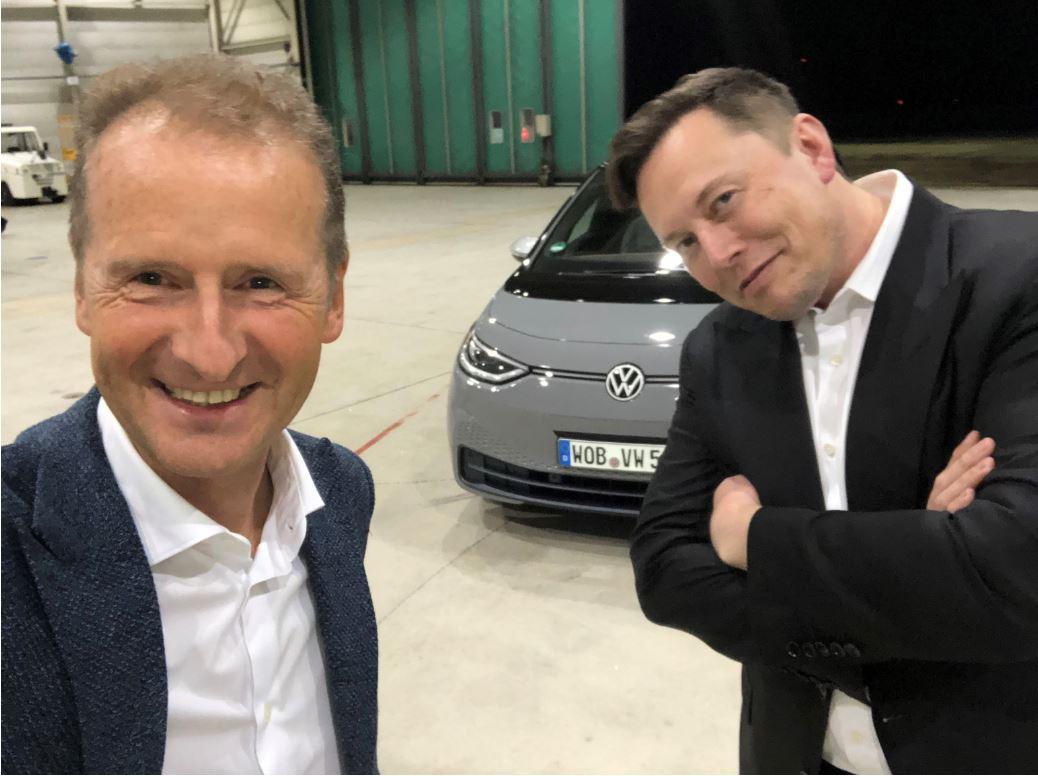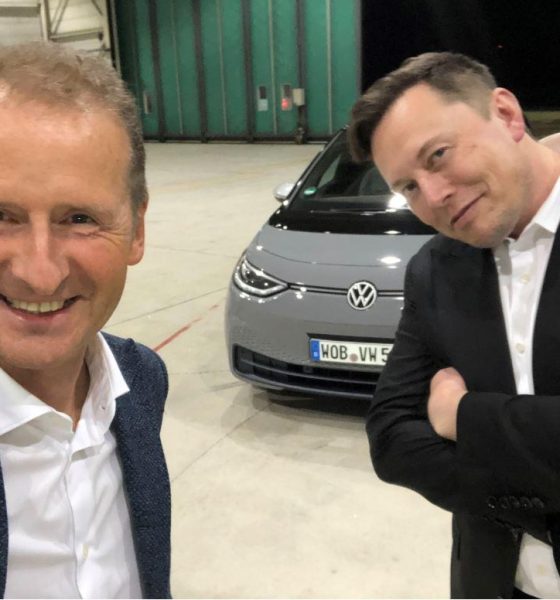

News
Amidst Tesla’s growing lead in the EV sector, VW boss rallies his troops to avoid being the next Nokia
The cellular phone industry was changed forever on June 29, 2007, when the first generation Apple iPhone was released to the public. It was a fresh and new idea that changed how mobile phones would be used and looked at forever. However, it was a wake-up call to Apple’s competitors and past cell phone manufacturers: Adapt or Fall Behind.
In Germany, a man named Herbert Diess, who runs a little car company called Volkswagen, is aware of the parallels between the automotive and cell phone sectors. Change happens. It happens fast, and if you don’t try to adapt to it, you won’t be relevant in a few years. Take Nokia, for example.
“Nokia is probably a good example of how such a change can happen—if you’re not fast enough, you’re not going to survive,” Diess said in an interview with Bloomberg. “I’m always telling our people this example.”
Nokia was arguably the most popular cell phone brand up until 2007. Most children used their Mom’s Nokia phone to play Snake while their parents shopped, giving it the versatility as a handy portable telephone and entertainment machine. However, Apple thought on a more broad scale and saw the cell phone as an opportunity to revolutionize the way people look at them. Instead of a few buttons and a low-resolution, pixelated screen, Apple got rid of most of the buttons and updated the software within a phone to show that it was capable of everything that a computer could do.
(Credit: AUTO BILD/YouTube)
Fast forward a few years, and Tesla is doing essentially the same thing with the automotive market. The company took the automobile and changed everything about it: the powertrain, the infotainment, the design, and the performance. Now, Volkswagen is trying to avoid becoming the Nokia of cars, looking to adapt to the global automotive market’s ever-changing look.
Volkswagen is arguably the automaker that supports the change to EVs the most of the companies with an ICE-based history. Interestingly, it is the same company that fended off a major emissions scandal within the last decade. However, it still has been the car company with the most support for Tesla and the transition to electrification.
Volkswagen has repaid Dieselgate victims an outrageous compensation package
Volkswagen’s transition begins with updating its currently-operating production plants to support the manufacturing process of EV powertrains. But that is not the biggest challenge the German automaker is facing, according to Diess.
“The bigger transition automotive will face is really as the car is becoming more and more of a software device,” he said, “gathering huge amounts of data, and then building up from the data artificial intelligence, knowledge about the driver, road conditions, safety, and then improving the way this device behaves.”
In regards to Tesla, Diess says that its lead is big, but that the company is helping “pull the industry” along with the guidance of CEO Elon Musk. “He’s a reference for us. If we look into our future and what the car has to become, it has to become electric, and it has to become an internet device.”
In the race to become the premier EV company, Volkswagen has a long way to go. Overtaking Tesla is in the company’s future plans, but Diess realizes that his company is ready for the challenges that lie ahead.
“I think we are the best-prepared company for the EV age. Europe will be one of the main hubs of electrification, and we are well prepared, so I’m happy. The big thing is managing through that transition. In 2024 and 2025, when cars really become Internet devices and start self-driving, I hope that we took the right decisions.”

Elon Musk
Starlink passes 9 million active customers just weeks after hitting 8 million
The milestone highlights the accelerating growth of Starlink, which has now been adding over 20,000 new users per day.

SpaceX’s Starlink satellite internet service has continued its rapid global expansion, surpassing 9 million active customers just weeks after crossing the 8 million mark.
The milestone highlights the accelerating growth of Starlink, which has now been adding over 20,000 new users per day.
9 million customers
In a post on X, SpaceX stated that Starlink now serves over 9 million active users across 155 countries, territories, and markets. The company reached 8 million customers in early November, meaning it added roughly 1 million subscribers in under seven weeks, or about 21,275 new users on average per day.
“Starlink is connecting more than 9M active customers with high-speed internet across 155 countries, territories, and many other markets,” Starlink wrote in a post on its official X account. SpaceX President Gwynne Shotwell also celebrated the milestone on X. “A huge thank you to all of our customers and congrats to the Starlink team for such an incredible product,” she wrote.
That growth rate reflects both rising demand for broadband in underserved regions and Starlink’s expanding satellite constellation, which now includes more than 9,000 low-Earth-orbit satellites designed to deliver high-speed, low-latency internet worldwide.
Starlink’s momentum
Starlink’s momentum has been building up. SpaceX reported 4.6 million Starlink customers in December 2024, followed by 7 million by August 2025, and 8 million customers in November. Independent data also suggests Starlink usage is rising sharply, with Cloudflare reporting that global web traffic from Starlink users more than doubled in 2025, as noted in an Insider report.
Starlink’s momentum is increasingly tied to SpaceX’s broader financial outlook. Elon Musk has said the satellite network is “by far” the company’s largest revenue driver, and reports suggest SpaceX may be positioning itself for an initial public offering as soon as next year, with valuations estimated as high as $1.5 trillion. Musk has also suggested in the past that Starlink could have its own IPO in the future.
News
NVIDIA Director of Robotics: Tesla FSD v14 is the first AI to pass the “Physical Turing Test”
After testing FSD v14, Fan stated that his experience with FSD felt magical at first, but it soon started to feel like a routine.

NVIDIA Director of Robotics Jim Fan has praised Tesla’s Full Self-Driving (Supervised) v14 as the first AI to pass what he described as a “Physical Turing Test.”
After testing FSD v14, Fan stated that his experience with FSD felt magical at first, but it soon started to feel like a routine. And just like smartphones today, removing it now would “actively hurt.”
Jim Fan’s hands-on FSD v14 impressions
Fan, a leading researcher in embodied AI who is currently solving Physical AI at NVIDIA and spearheading the company’s Project GR00T initiative, noted that he actually was late to the Tesla game. He was, however, one of the first to try out FSD v14.
“I was very late to own a Tesla but among the earliest to try out FSD v14. It’s perhaps the first time I experience an AI that passes the Physical Turing Test: after a long day at work, you press a button, lay back, and couldn’t tell if a neural net or a human drove you home,” Fan wrote in a post on X.
Fan added: “Despite knowing exactly how robot learning works, I still find it magical watching the steering wheel turn by itself. First it feels surreal, next it becomes routine. Then, like the smartphone, taking it away actively hurts. This is how humanity gets rewired and glued to god-like technologies.”
The Physical Turing Test
The original Turing Test was conceived by Alan Turing in 1950, and it was aimed at determining if a machine could exhibit behavior that is equivalent to or indistinguishable from a human. By focusing on text-based conversations, the original Turing Test set a high bar for natural language processing and machine learning.
This test has been passed by today’s large language models. However, the capability to converse in a humanlike manner is a completely different challenge from performing real-world problem-solving or physical interactions. Thus, Fan introduced the Physical Turing Test, which challenges AI systems to demonstrate intelligence through physical actions.
Based on Fan’s comments, Tesla has demonstrated these intelligent physical actions with FSD v14. Elon Musk agreed with the NVIDIA executive, stating in a post on X that with FSD v14, “you can sense the sentience maturing.” Musk also praised Tesla AI, calling it the best “real-world AI” today.
News
Tesla AI team burns the Christmas midnight oil by releasing FSD v14.2.2.1
The update was released just a day after FSD v14.2.2 started rolling out to customers.

Tesla is burning the midnight oil this Christmas, with the Tesla AI team quietly rolling out Full Self-Driving (Supervised) v14.2.2.1 just a day after FSD v14.2.2 started rolling out to customers.
Tesla owner shares insights on FSD v14.2.2.1
Longtime Tesla owner and FSD tester @BLKMDL3 shared some insights following several drives with FSD v14.2.2.1 in rainy Los Angeles conditions with standing water and faded lane lines. He reported zero steering hesitation or stutter, confident lane changes, and maneuvers executed with precision that evoked the performance of Tesla’s driverless Robotaxis in Austin.
Parking performance impressed, with most spots nailed perfectly, including tight, sharp turns, in single attempts without shaky steering. One minor offset happened only due to another vehicle that was parked over the line, which FSD accommodated by a few extra inches. In rain that typically erases road markings, FSD visualized lanes and turn lines better than humans, positioning itself flawlessly when entering new streets as well.
“Took it up a dark, wet, and twisty canyon road up and down the hill tonight and it went very well as to be expected. Stayed centered in the lane, kept speed well and gives a confidence inspiring steering feel where it handles these curvy roads better than the majority of human drivers,” the Tesla owner wrote in a post on X.
Tesla’s FSD v14.2.2 update
Just a day before FSD v14.2.2.1’s release, Tesla rolled out FSD v14.2.2, which was focused on smoother real-world performance, better obstacle awareness, and precise end-of-trip routing. According to the update’s release notes, FSD v14.2.2 upgrades the vision encoder neural network with higher resolution features, enhancing detection of emergency vehicles, road obstacles, and human gestures.
New Arrival Options also allowed users to select preferred drop-off styles, such as Parking Lot, Street, Driveway, Parking Garage, or Curbside, with the navigation pin automatically adjusting to the ideal spot. Other refinements include pulling over for emergency vehicles, real-time vision-based detours for blocked roads, improved gate and debris handling, and Speed Profiles for customized driving styles.








